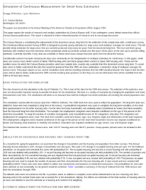
An official website of the United States government
Here’s how you know
Official websites use .gov
A .gov website belongs to an official government organization in the United States.
Secure .gov websites use HTTPS
A lock (
) or https:// means you’ve safely connected to the .gov website. Share sensitive information only on official, secure websites.
-
//
- Census.gov /
- Census Working Papers /
- Simulation of Continuous Measurement for Small Area Estimation
Simulation of Continuous Measurement for Small Area Estimation
Simulation of Continuous Measurement for Small Area Estimation
The paper was presented at the Annual Meeting of the American Statistical Association (ASA), August 1995.
The Census Bureau is considering the replacement of the decennial census long form for the collection of the sample data with a continuous survey. The Continuous Measurement Survey (CMS) is designed to provide yearly estimates for large areas and multiyear averages for small areas. This will provide timely estimates for large areas that are currently produced only every ten years from the decennial long form. The tract and block group estimates (the smallest area that estimates will be produced) would accumulate sample over five years (three years at the start up) to provide rolling estimates. Currently very little, if any, data are available at these small areas except every ten years from the decennial census.
Considerable concern has been raised by the data-user community on the interpretation of multiyear estimates for small areas. In this paper, small areas are census tracts which consist of about 1000 housing units and block groups which consist of about 300 housing units. These are the smallest areas for which the Census Bureau provides small area sample data, usually only available from the decennial census long form. To assist data users to better understand the data that would be produced from the CMS, we have undertaken a simulation study of multiyear averages for census tracts. This paper reports on our current simulation work and the resulting estimates that the CMS would produced. Our hope is that the data users will be able to better understand the CMS and the resulting data products so that they can use the information that will be available from the CMS to fill their data needs.
Others in Series
Working Paper
Working Paper
Working Paper
Share
Some content on this site is available in several different electronic formats. Some of the files may require a plug-in or additional software to view.
 Yes
Yes
 No
NoComments or suggestions?


Top

